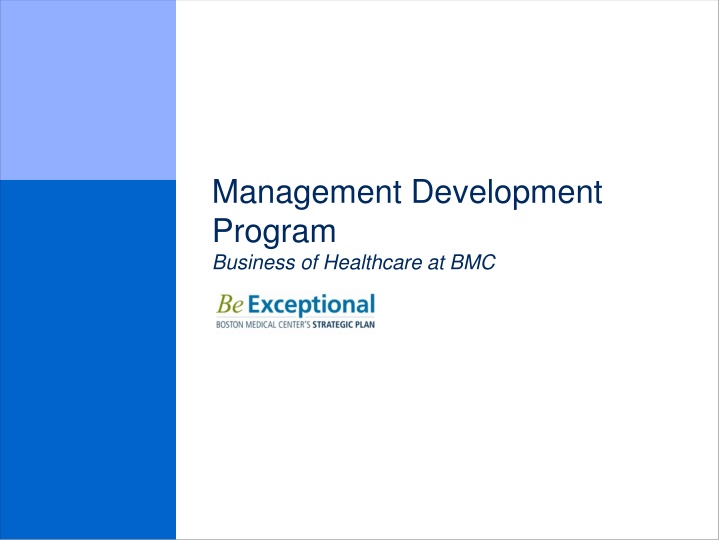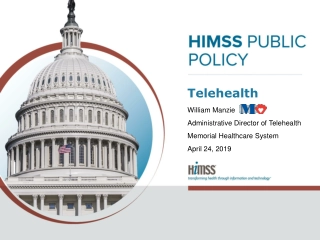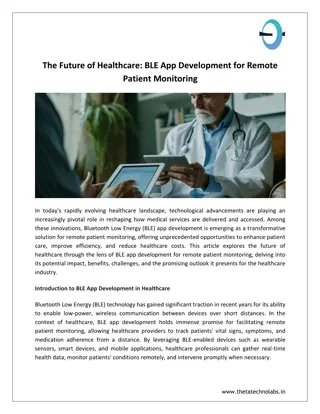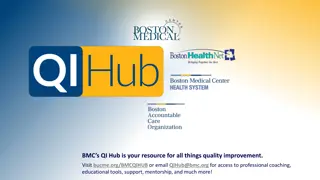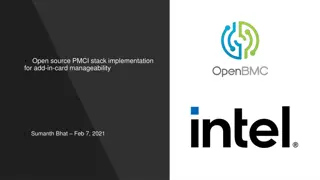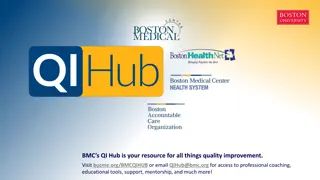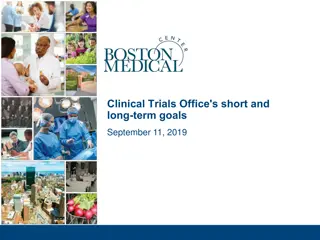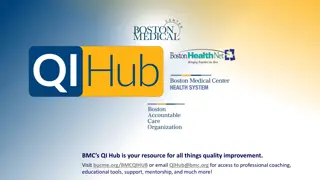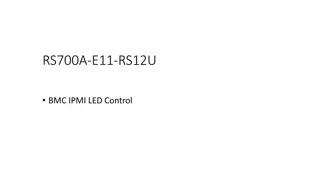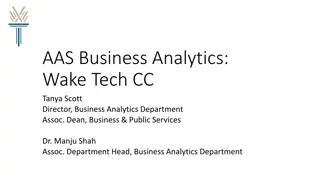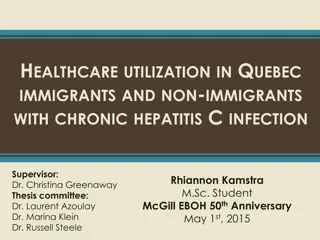Management Development Program: Business of Healthcare at BMC
Enhance your strategic management skills at BMC's Management Development Program focusing on the business side of healthcare. Explore how changes in the market impact BMC and improve employee engagement through effective communication tools.
Download Presentation

Please find below an Image/Link to download the presentation.
The content on the website is provided AS IS for your information and personal use only. It may not be sold, licensed, or shared on other websites without obtaining consent from the author.If you encounter any issues during the download, it is possible that the publisher has removed the file from their server.
You are allowed to download the files provided on this website for personal or commercial use, subject to the condition that they are used lawfully. All files are the property of their respective owners.
The content on the website is provided AS IS for your information and personal use only. It may not be sold, licensed, or shared on other websites without obtaining consent from the author.
E N D
Presentation Transcript
Management Development Program Business of Healthcare at BMC
Session Objectives By understanding the business side of BMC, participants will be better able to: Connect their management roles to the overall business goals of BMC Explain how changes to the market and business environment affect BMC Improve our ability to respond to changes in the business environment. Increase employee engagement with the use of tools to better communicate business operations to your teams 1
Session Outline Introduction, Session Objectives and Outline Hospital Facts and Hot Topics o How does BMC make money? o Patient and Revenue Cycles Volume, Volume, Volume! 2
Hospital Types Hospitals are registered with the American Hospital Association as one of the following types: General Provide patient services, diagnostic and therapeutic, for a variety of medical conditions. Boston Medical Center is a General Acute Care Hospital. Specialty Provide diagnostic and treatment services for patients who have specified medical conditions, both surgical and nonsurgical Rehabilitation and Chronic Diseases Provide diagnostic and treatment services to disabled individuals requiring restorative and adjustive services Psychiatric Provide diagnostic and therapeutic services for patients who require psychiatric-related services 4
Hospital Types Hospitals are organized as Public hospitals In general, public hospitals provide substantial services to patients living in poverty. Federal hospitals serve specific purposes or communities Public hospitalsare often funded in part by a city, county, tax district, or state. Private, not-for-profit hospitals Are nongovernment entities organized for the sole purpose of providing health care. Roughly 87 percent of nonfederal community hospitals are not-for-profit. In return for providing charitable services, these hospitals receive numerous benefits, including exemption from federal and state income taxes and exemption from property and sales tax. Boston Medical Center is a private, not-for-profit hospital. Private for profit hospitals The remaining nonfederal community hospitals are investor-owned,which means that they have shareholdersthat may benefit from profits generated by the hospital. For- profit hospitals do not share the charitable mission of not-for-profit hospitals (though many do provide some charity services), and they must pay taxes. 5
Boston Medical Center Hospital Facts Sheet Staffed Beds: Medicine/Surgery Obstetrics/Gynecology Intensive and Coronary Care Neonatal Intensive Care Nursery Pediatric Intensive Care Pediatrics Rehabilitation* Total FY12 FY13 FY14 Patient Activity: Discharges Outpatient Clinic Outpatient Ancillary Emergency Room Ambulatory Surgery Outpatient Observation Total FY12 26,132 656,940 243,528 129,714 28,382 8,126 1,092,822 FY13 26,035 681,177 189,745 129,783 27,840 7,792 1,062,372 FY14 26,119 720,132 206,297 128,839 29,406 7,928 1,118,721 306 47 58 21 34 300 32 58 22 34 300 32 58 22 34 6 6 6 30 9 511 30 0 482 30 0 482 Employees: Hospital FTEs 4,506 4,573 4,767 Average Length of Stay Medical/Surgical Newborn (Includes NICU) Occupancy Rate (Staffed Beds) 4.73 4.73 70.6% 4.95 4.66 75.9% 5.29 4.60 79.2% * Rehab unit closed 7/1/2012; FY12 reflects 9 months of operation 6
Hot Topics Revenue How does BMC make money? 7
Hospital Revenue Terminology Typically, hospitals get their revenue in a variety of ways: By providing medical services For nonmedical services Through donations and grants from individuals, foundations, or the government Through gains on investments Hospitals group the way they make money into three different categories: Operating Revenue: delivery of patient care Other Operating Revenue: nonpatient care activities Non-Operating Revenue: peripheral business activities 8
Hospital Revenue - Payers To understand how hospitals generate revenue for patient services, it is important to understand the payers in the healthcare industry. Public payers include federal and state governments which fund Medicare and Medicaid Private payers are insurance companies. Finally, there is the uninsured population, which includes people who are expected to pay for their own health care, unless they qualify for charity/free care as defined by the hospitals internal policies. 9
Patient Demographics Highlights: BMC s payor mix is substantially different from other hospitals 81% of BMC revenue comes from governmental sources Governmental rates of payments are generally not negotiable Any payments shortfalls are magnified by BMC s payor mix 10
Acute Hospital Financial Performance, by Hospital System: FY11 Highlights: Partners and Care Group hospital systems make up 52% of the entire profit in the state. Mass General Hospital alone makes up 24% of the entire profit in the state. BMC had the largest loss for an individual hospital in the state. Steward Health Care System (10 hospitals) had the largest combined loss in the state. 11
Hot Topics Patient and Revenue Cycles Patient/Revenue Cycle 12
Revenue Cycle Overview CODING & CHARGE CAPTURE CLINICAL DOCUMENTATION HIM, CODING CLAIMS EDITING SUBMISSION UTILIZATION REVIEW / CASE MGMT FINANCIAL COUNSELING THIRD PARTY COLLECTIONS Patient Care COPAYMENT COLLECTION PAYMENT POSTING DENIALS / AUDIT MGMT REGISTRATION CONTRACT MGMT PRE- REGISTRATION SCHEDULING 13
The Changing Economy Revenue Related Challenges: Reduction/Lag in Governmental Dollars Owed to BMC Governor s Budgetary Powers Future Years Not Yet Secured Reduced Demand for Healthcare, Fewer Elective Procedures Changes to insurance reimbursements: tiers and pay for performance Change from fee-for-service to payment for population management 14
Types of Patient Volume Category Patients in Beds Inpatients in Beds Definition Inpatient Discharge Admission to a hospital bed for inpatient care Outpatients in Beds Observation Admission to a hospital bed for observation, typically <24 hours, but may stay longer Admission to a hospital bed for extended recovery after an outpatient procedure (OR, Cath Lab, etc.) Bedded Outpatient Other Outpatient Services Clinic Visit Doctor's office visit - may also include minor procedure Treated in the Emergency Department and released to home Operating Room, Cardiac Cath, EP Lab, Endoscopy or other significant outpatient procedure. Emergency Room Surgical Day Care Other Outpatient Services Radiology (MRI, CT, US, Xray, etc.), Cardiology (EKG), PT/OT, Lab, etc.) Outpatient Pharmacy Outpatient Retail Pharmacy Bedded outpatients: BMC typically receives payment for the procedure (SDC) but no added payment for the care on the inpatient nursing unit. 16
Annual Inpatient Discharge Trend FY08 - FY15 Annual Inpatient Discharge Trend 6.00% 4.9% 4.00% 2.8% 2.5% 2.00% 0.1% 0.1% % Growth / (Decline) 0.00% -0.4% -2.00% -4.00% -4.3% -6.00% -8.00% -10.00% -9.9% -12.00% FY08 FY09 FY10 FY11 FY12 FY13 FY14 Projected FY15 Budget Period FY14 FY15 Budget 26,632 Fiscal Year Discharges FY08 29,357 FY09 30,179 FY10 30,215 FY11 28,917 FY12 26,060 FY13 25,959 Projected 25,986 Highlights FY15 IP discharges are projected to grow 646 discharges (or 2.5%) to 26,632 from FY14 projection of 25,986 FY14 IP discharges are projected to increase 0.1% from FY13 associated with strong inpatient Medicine discharge volumes 17
Boston Organization of Teaching Hospital Financial Officers (BOTHFO): December 2014 Volume Report Discharges (3 Months) Patient Days (3 Months) FY15 YTD Discharges 11,479 13,586 58,208 FY14 YTD Discharges 11,639 13,162 56,940 FY15 YTD Patient Days 51,341 31,215 65,453 27,609 26,106 77,370 16,128 23,670 321,454 FY14 YTD Patient Days 45,111 31,146 65,539 26,683 25,256 77,958 15,340 23,698 313,193 % Change % Change BIDMC BMC BWH Children's DFCI Lahey MGH St. E's Tufts Total 9,669 6,409 8,442 6,521 14.5% -1.7% -1.4% 2.0% -19.7% 1.5% 3.2% -1.5% -3.5% 2.2% 13.8% 0.2% -0.1% 3.5% 4.1% 3.4% -0.8% 5.1% -0.1% 2.6% 3,939 245 5,285 3,862 305 5,206 2,562 2,462 3,221 4,375 3,270 4,533 Total Excl. BMC 51,799 50,419 2.7% 290,239 282,047 2.9% Highlights As of December of FY15, BMC s inpatient discharges were down 1.7% for the year while the average for other BOTHFO hospitals was up 2.7%. 18
Market Forces are Leading to Lower Inpatient Volumes Stricter Requirements for Inpatient Admission Changing technology and requirements for inpatient admission resulting in more observation and surgical day care patients Care Management Medical home model leading to lower admission rates from Medicine and Family Medicine Reduced readmission rates due to penalties (Medicare, Medicaid) Efforts to limit Emergency Room usage Competitors New emergency rooms and service guarantees from other Boston ER s, along with efforts to attract specific patient populations (Carney marketing to Vietnamese patients). Falling ER volume (walk-ins, ambulance and trauma) from BMC s core market areas. Competitors consolidating referral networks and cutting out BMC For example: New Steward arrangement with Partners for trauma care Rate differentials make it difficult for BMC to grow its network Financial Pressures on Patients The economic downturn, combined with increased prevalence of high-deductible health plans, results in fewer elective procedures 19
The Right Careno more, no less Can only work if there is volume! Patients can be divided into 4 groups based on the front door they use to arrive at BMC: Emergency Walk-In & Other Emergency Ambulance 10,000 9,600 9,380 9,600 8,993 9,223 9,200 9,200 8,800 8,800 8,341 8,400 8,034 8,400 Actual 7,888 Actual 8,000 7,977 8,000 7,383 7,600 7,972 7,600 7,090 Budget Budget 6,908 7,200 7,200 6,996 6,800 6,800 2010 2011 2012 2013 2014 6,400 2010 2011 2012 2013 2014 Elective BMC/CHC Elective Non-BMC/CHC 10,000 5,800 9,600 5,400 9,200 5,000 8,800 4,600 8,400 3,940 7,929 4,200 7,815 Actual 3,709 Actual 8,000 7,789 3,539 3,800 3,506 7,350 Budget 3,279 Budget 7,600 3,400 7,431 7,590 7,200 3,287 3,000 6,800 2,600 2010 2011 2012 2013 2014 2010 2011 2012 2013 2014 20
Emergency Admissions -- Volume vs Budget January 2013 to December 2014 Emergency admissions in FY15 are down 5.6% from budget (221 discharges) and 4.3% from prior year. ED admissions account for 72% of the total inpatient variance to budget. Emergency Admits: FY15 Bud 3,945 3,724 -5.6% % Growth FY14 Act FY15 Act 3,890 3,724 -4.3% FY15 Act % Var Inpatient Discharges Emergency Admits 1,500 Actual Budget 1,400 1,380 1,351 1,337 1,332 1,325 1,297 1,300 1,278 1,287 1,250 1,265 1,265 1,266 1,271 1,215 1,251 1,230 1,261 1,243 1,244 1,200 1,167 1,134 1,100 1,122 1,111 1,108 1,000 Nov-13 Nov-14 Jul-13 Jul-14 Jan-14 Jan-13 Apr-13 Apr-14 Sep-13 Dec-13 Sep-14 Dec-14 Aug-13 Oct-14 Aug-14 Oct-13 May-14 May-13 Jun-14 Feb-13 Jun-13 Feb-14 Mar-13 Mar-14 21
Monthly Walk-in Volume Trend Walk-in volume has been decreasing since June 2014 (on average 511 visits per month for the last 7 months). Walk-in Volume by Month 9000 8000 7000 6000 Volume 5000 4000 3000 2000 1000 0 Jan 8087 7722 Feb 6387 6817 Mar 7757 7948 Apr 7671 7795 May 8450 7965 Jun 7951 7440 Jul 8275 7072 Aug 8056 7402 Sep 7757 7308 Oct 7868 7279 Nov 7041 6113 Dec 7392 6513 2013 2014 22
Questions? 23
Wrap-Up 24 Thank You!
